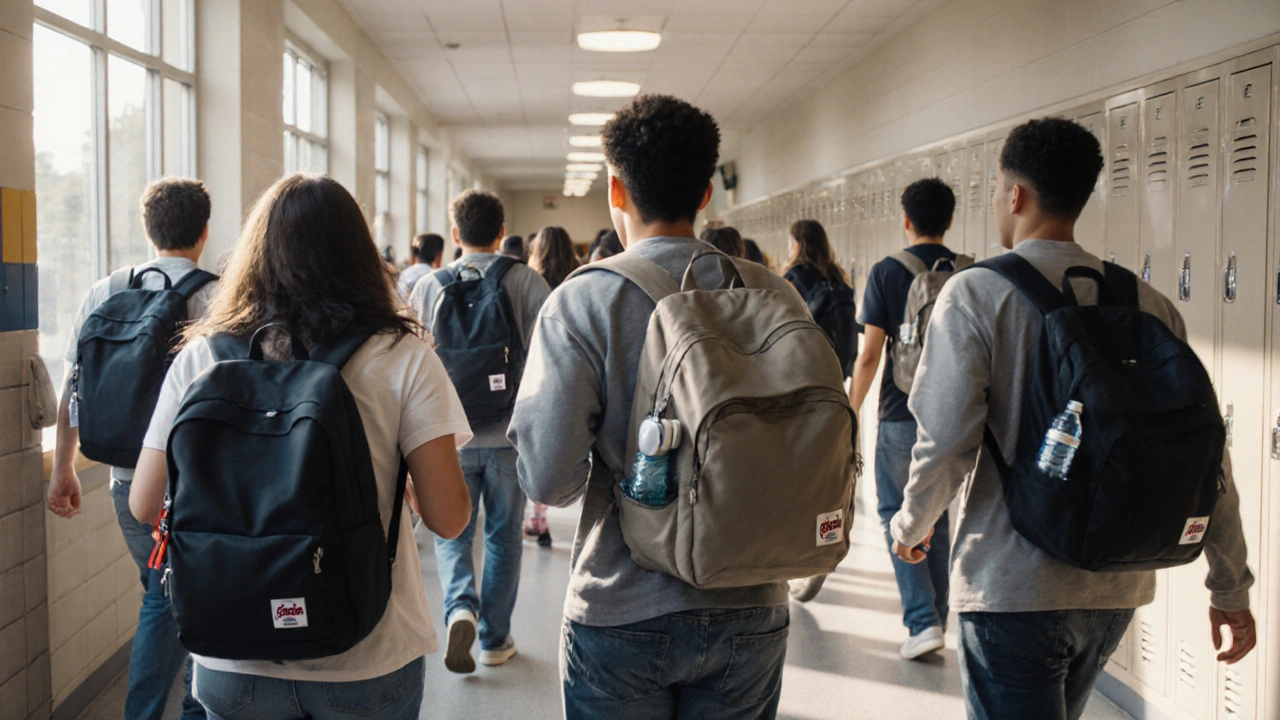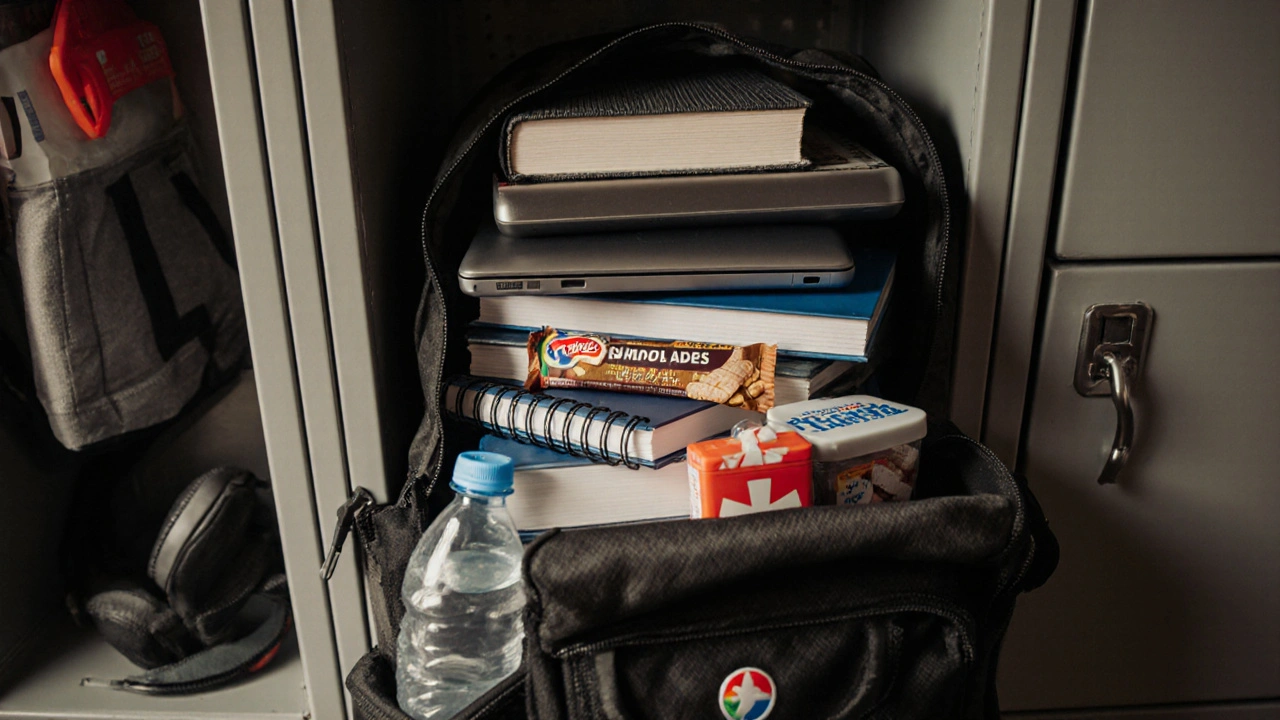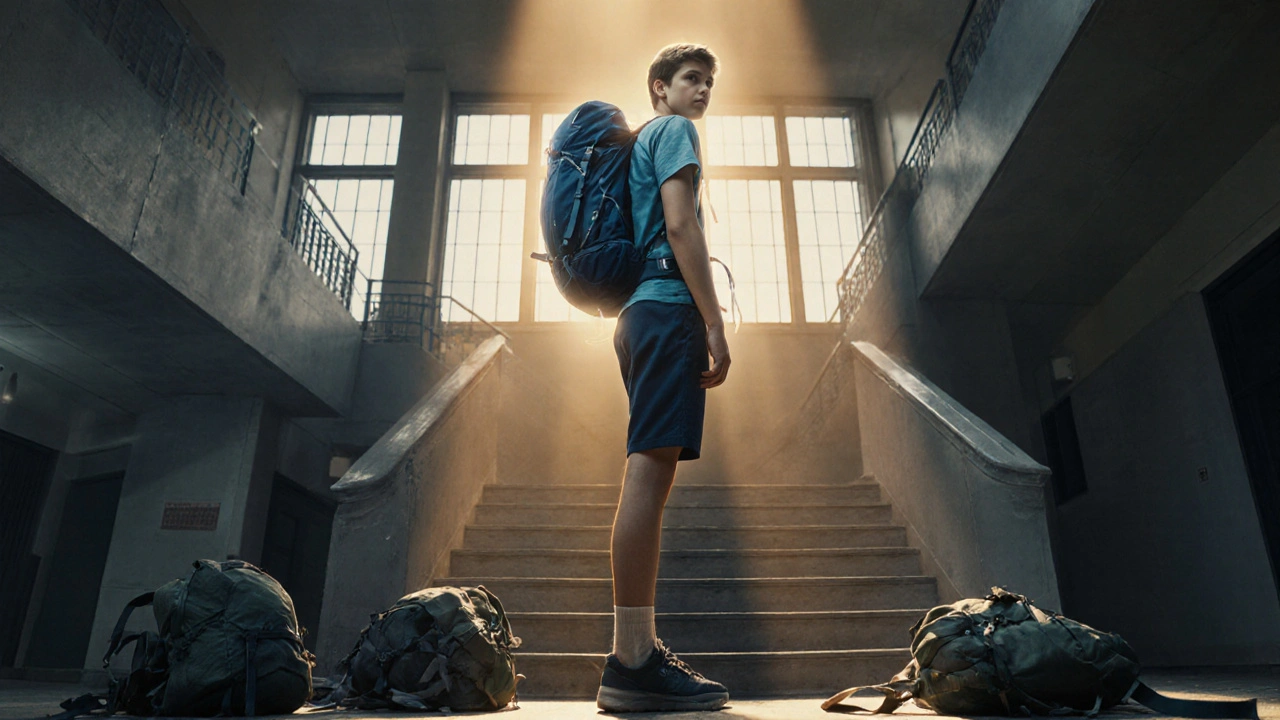Do People Use Backpacks in High School? Here’s What Students Really Carry Today

Walk through any high school hallway at 7:45 a.m. and you’ll see them-backpacks slung over shoulders, dragging behind kids rushing to class. But are they still the go-to? Or have things changed with laptops, rolling bags, and digital planners? The short answer: yes, students still use backpacks. But not the way their parents did.
Backpacks Are Still the Norm-But They’ve Changed
According to a 2024 survey of over 12,000 U.S. high school students, 92% carry a backpack daily. That’s up from 85% in 2019. The reason? Schools haven’t gone fully digital. Textbooks still exist. Labs need supplies. Art classes require sketchbooks. Even with Chromebooks and tablets, students still lug around physical materials.
But today’s backpacks look different. They’re lighter. They have padded laptop sleeves. Some even have built-in USB ports and power banks. The classic canvas duffel? Rare. The modern favorite? A structured, ergonomic design with hip belts and breathable mesh. Brands like Herschel, JanSport, and Deuter dominate the market-not because they’re trendy, but because they actually work.
One 10th grader in Denver told me: "I used to hate my backpack until I got one with a lumbar support pad. Now I don’t feel like I’m carrying a fridge on my back after third period."
What’s Inside the Backpack? A Real Inventory
Forget the cartoon image of a backpack bursting with textbooks. Real student gear is more practical-and surprisingly varied.
- Textbooks: 3-5 per day, depending on schedule. Heavy ones like biology or physics can weigh 4-6 pounds each.
- Laptop or tablet: 90% carry one. Most schools require it for note-taking and assignments.
- Binders and notebooks: 2-4 binders with dividers, plus 3-5 spiral notebooks. Some switch to digital, but paper still wins for math and science.
- Water bottle: Nearly universal. Schools ban sugary drinks, so hydration is mandatory.
- Snacks: Granola bars, fruit, or trail mix. Lunch periods are short. Hunger doesn’t wait.
- Headphones: 78% use them to block noise between classes or during study halls.
- Emergency kit: Band-aids, pain relievers, hand sanitizer, tissues. A lot of students carry these after getting sick in class.
That’s an average load of 12-18 pounds. The American Academy of Pediatrics says kids should carry no more than 10-15% of their body weight. For a 130-pound teen, that’s 13-20 pounds. So most are right on the edge.
Why Not Rolling Bags?
You’d think rolling bags would win. They’re easier on the back. But schools aren’t built for them.
Stairs. Narrow hallways. Crowded lockers. Cafeteria lines. Most high schools were built before 2000. Rolling bags get stuck. They trip people. Teachers often ban them during fire drills.
A 2023 study by the National Association of School Nurses found that 68% of schools have policies against rolling bags due to safety concerns. Even in newer buildings, lockers are too shallow for large wheels. And don’t forget-students often carry their bags up and down stairs multiple times a day. Rolling bags don’t help there.
Plus, there’s the social factor. Rolling bags look like they belong in an airport. Backpacks? They’re part of the uniform.

What Makes a Good High School Backpack?
Not all backpacks are created equal. The best ones balance comfort, durability, and smart design.
Key features students actually care about:
- Padded shoulder straps: Non-negotiable. Thin straps dig in after 20 minutes.
- Waist or chest strap: Helps distribute weight. Many students don’t realize how much this helps until they try it.
- Laptop compartment: Must fit a 15-inch device. Most schools use 15-inch Chromebooks.
- Water-resistant material: Rain, snow, spilled drinks-it happens. A $30 backpack soaked through after one storm isn’t worth it.
- Multiple compartments: One for books, one for tech, one for snacks. Organization saves time.
- Lightweight frame: A backpack that weighs 2 pounds empty is better than one that weighs 4.
Brands like JanSport is a durable, affordable backpack brand popular among U.S. high school students since the 1980s still lead because they’ve kept it simple. Herschel is a stylish, well-padded backpack brand favored by teens for its modern design and comfort features wins for looks and comfort. Deuter is a German brand known for ergonomic backpacks with excellent weight distribution, used by students who carry heavy loads daily is the pick for athletes and students in STEM programs who lug lab gear.
What Students Wish They Knew Before Buying
Here’s what real students say they regret:
- Buying a backpack with no back padding. "I thought it looked cool. My shoulders hurt all year."
- Getting one with a zipper that breaks after two months. "I spent $80 on a "premium" one. It fell apart in October."
- Ignoring size. "I got a huge one thinking I’d fit everything. Turns out I just carried junk."
- Not checking school rules. Some schools ban backpacks in classrooms. Others require specific colors.
Pro tip: Buy in late July. Prices drop 30-50% after summer rush. Look for sales at Target, Walmart, or REI. Avoid impulse buys at the mall in August.

Are Backpacks Really Necessary?
Some schools are moving toward digital-only systems. A few districts in California and New York have started giving students tablets with all textbooks loaded. But even there, students still bring physical notebooks, chargers, and headphones.
And here’s the thing: backpacks aren’t just for books. They’re for identity. For safety. For survival.
They hold your spare clothes if you get caught in the rain. They carry your meds if you have asthma or allergies. They hold your phone when you can’t keep it in your pocket. They’re the only thing that fits your lunch, your gym shoes, your sketchbook, and your emotional baggage.
So yes-people still use backpacks in high school. Not because they’re stuck in the past. But because they still work.
Do high school students still carry textbooks in backpacks?
Yes, most do. Even in schools with Chromebooks, students carry 3-5 physical textbooks daily, especially for science, math, and history. Digital textbooks aren’t always allowed for note-taking, and many teachers still assign printed readings.
Is it safe for teens to carry heavy backpacks?
It can be. The American Academy of Pediatrics recommends students carry no more than 10-15% of their body weight. A 150-pound student shouldn’t carry over 22.5 pounds. Using a backpack with padded straps, a waist belt, and proper weight distribution reduces injury risk. If a student complains of back or shoulder pain, it’s time to lighten the load or switch bags.
Why don’t more students use rolling backpacks?
Most high schools aren’t designed for them. Narrow hallways, stairs, crowded lockers, and fire drills make rolling bags impractical. Many schools ban them for safety reasons. Rolling bags also get stuck or trip people in tight spaces. Backpacks are faster, more maneuverable, and more reliable in a school environment.
What’s the average weight of a high school student’s backpack?
On average, students carry 12-18 pounds daily. That includes textbooks, laptops, binders, water bottles, snacks, and personal items. Some STEM or AP students carry over 20 pounds. The heaviest loads are usually on days with lab work or physical education.
Are expensive backpacks worth it for high school?
Not always. A $120 backpack isn’t necessarily better than a $40 one-if the cheaper one has padded straps, a laptop sleeve, and durable zippers. Look for key features, not brand names. Many students find that mid-range options from JanSport, Amazon Basics, or Target’s Merona last just as long as premium brands.
Should I get a backpack with a USB port and power bank?
Only if you need it. Most students charge devices during lunch or at home. Built-in power banks add weight and cost. If your school has charging stations, skip it. If you’re always on the go and can’t find outlets, then yes-but make sure the port is reliable. Many cheap built-in chargers fail after a few months.
Next Steps: Choosing Your Backpack
Here’s how to pick one that lasts:
- Measure your current load. Weigh your bag with everything inside. If it’s over 15% of your body weight, cut down.
- Try it on. Walk around with it loaded. Check if straps dig in or if it pulls you backward.
- Check the zippers. Pull them hard. If they snag, skip it.
- Look for a lifetime warranty. JanSport and Deuter offer them. It’s worth it.
- Buy early. Late July sales are your best bet. Avoid August rush prices.
Backpacks aren’t going away. They’re evolving. And if you pick the right one, it won’t just carry your stuff-it’ll help you get through the day without pain, stress, or frustration.
Lissa Veldhuis
November 20, 2025 AT 04:33My backpack had a zipper that broke in October and I spent $80 on it so yeah that was a lesson learned
Now I just use a $25 JanSport from Target and it’s still going strong after two years
Who even needs fancy features when the basics work
David Smith
November 20, 2025 AT 05:01Let’s be real nobody cares about ergonomic design until their spine starts collapsing
My friend’s kid got one of those Deuter things with the hip belt and now he walks like a robot
Still better than the 20 pound brick he was dragging before I guess
But come on this is high school not a mountain climb
Michael Jones
November 20, 2025 AT 09:33Backpacks are just modern-day carrying vessels for our emotional and academic burdens
It’s not about the weight it’s about what it holds
Your meds your sketchbook your half-eaten granola bar your hope for tomorrow
That’s the real payload
And yeah maybe we’re all carrying too much but at least we’ve got something to hold it all
allison berroteran
November 21, 2025 AT 16:05I’ve been thinking about this a lot because I carry about 17 pounds every day and I didn’t realize how much it affects my posture until I started doing yoga
Now I use a waist strap and I swear it’s changed my life
Also I stopped bringing my full set of art supplies and just take what I need for the day
It’s amazing how much junk we convince ourselves we need
Turns out you don’t need five different highlighters and three erasers and a whole notebook just for math
One good pen and one notebook is enough
And yes I still bring my water bottle because dehydration makes me rage and no one wants that
Gabby Love
November 23, 2025 AT 14:32Just a quick note: the AAP recommends 10-15% of body weight, not 15-20% as some people think
So for a 120-pound student, max is 18 pounds
Also, if your backpack weighs more than your laptop, you’re probably carrying too much
And yes, rolling bags are banned in most schools not because they’re bad but because they’re dangerous in crowds
Stairs + wheels + 150 teens rushing = disaster waiting to happen
Jen Kay
November 24, 2025 AT 06:28Oh please the fact that we’re still having this conversation in 2024 is ridiculous
Of course backpacks are necessary
It’s not about tradition it’s about function
And if you think a $120 Herschel is worth it just because it has a cute logo you’re part of the problem
Buy something that works not something that looks good in a TikTok video
Also why are we surprised that schools built in 1978 can’t handle rolling bags?
Maybe fix the infrastructure before blaming the students
Michael Thomas
November 25, 2025 AT 01:35USA still wins. No other country makes backpacks this practical.
Rolling bags? That’s a European problem.
We got stairs. We got hustle. We got JanSport.
End of story.
Abert Canada
November 25, 2025 AT 12:46Backpacks in Canada are the same but we use them to carry hot chocolate and maple syrup packets in winter
Also our schools have better heating so we don’t need as many layers
But yeah the weight issue is universal
My cousin in Toronto carries 19 pounds and says she’s fine
She also has a chiropractor on speed dial
So maybe don’t be that person
Xavier Lévesque
November 26, 2025 AT 10:10Ha. I bought the cheapest backpack I could find because I thought I’d outgrow it
It’s still with me after three years
Zippers intact
Straps not frayed
And I’ve never once felt like I was carrying a fridge
Turns out you don’t need a brand name to survive high school
Just common sense and a little patience
Thabo mangena
November 27, 2025 AT 19:36In South Africa, students often carry their textbooks in cloth sacks because backpacks are expensive
Some walk 10 kilometers to school and still manage to carry everything
It is not about fashion or ergonomics
It is about necessity
But I am glad that in your country you have the luxury to discuss padding and USB ports
It is a sign of progress
Still, the lesson remains: carry only what you need
And always, always respect your spine
Karl Fisher
November 28, 2025 AT 22:16Let me guess… the author works for Herschel
Or maybe JanSport paid them to write this
Everything in this post reads like a corporate ad disguised as journalism
And don’t get me started on the "emotional baggage" line
That’s not profound that’s a slogan from a 2018 Instagram post
Backpacks are tools not therapy
Buddy Faith
November 30, 2025 AT 18:42Backpacks are a government conspiracy to make kids fat
They want you weak so you’ll stay in school longer
Rolling bags would solve everything
But they banned them because the system hates efficiency
Also the USB ports are fake
They’re just there to make you think you’re tech-savvy
Meanwhile your charger is still in your locker
Scott Perlman
December 1, 2025 AT 18:16Just buy a good one and don’t overthink it
Straps good
Zippers work
Doesn’t leak
That’s it
Everything else is noise
Sandi Johnson
December 3, 2025 AT 15:22Oh so now we’re giving backpacks emotional significance
Next you’ll tell me my lunchbox holds my dreams
Look I get it
It’s a metaphor
But can we please stop pretending that a $90 bag is a life-changing purchase
It’s a bag
It holds stuff
And if it’s too heavy you’re doing something wrong
Also why is everyone so surprised that schools aren’t designed for wheels
It’s not a mystery
It’s called architecture
Eva Monhaut
December 4, 2025 AT 02:06What no one talks about is how backpacks become extensions of identity
That one with the patch from the band you saw at the fair
The one with the doodles on the side from third period art class
The way you adjust the straps when you’re nervous
The way you toss it on the floor like it’s the only thing you own
It’s not just about weight distribution or padded shoulders
It’s about the quiet rituals of being a teenager
And yeah maybe it’s heavy
But sometimes the things that weigh us down are the same things that keep us grounded
So buy smart
But also keep the little things
Even if they’re useless
They’re yours